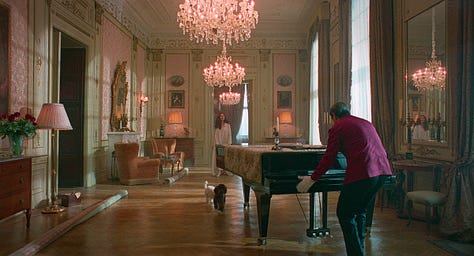Few films manage to capture a character’s essence through their surroundings as beautifully as Pablo Larraín’s Maria. Starring Angelina Jolie as the opera legend Maria Callas, the film is a visual masterpiece, particularly in its portrayal of Callas’s Paris apartment—a space that reflects her sophistication, culture, and grandeur.
For me, the apartment was the unexpected star of the film. From the very first scene, it was clear that every detail was carefully chosen to reflect her passions, her personality, and her larger-than-life aura. The bedroom, in particular, stood out as a space that perfectly embodied her romantic and refined taste.
It’s rare for a set design to evoke such a strong emotional response, but this one was exceptional. Guy Hendrix Dyas, the film’s production designer, has a talent for creating spaces that are both visually stunning and deeply resonant. Watching Maria, I felt like I was seeing a true work of art—a showcase of European interior design that goes beyond beauty to tell a story.
What makes European opulence so instantly recognizable? To understand, I dove into the key elements of Maria Callas’s apartment, comparing them to iconic European interiors from Parisian salons to grand historic homes. High ceilings, intricate moldings, and ornate door frames set the stage, while walls adorned with detailed designs and textures—often complemented by large paintings in gilded frames—enhanced the visual drama. Luxurious fabrics like silk and velvet, polished marble finishes, crystal chandeliers, and gilded accents brought richness to the interiors, while antique furniture, grand oil paintings, and carefully curated art collections anchored the rooms in history and sophistication.
European design is never about excess. Instead, it strikes a balance between richness and restraint, ensuring spaces feel opulent but never overwhelming. Every element showcases an artistry that elevates the space beyond functionality. These details create a sense of wonder, and each piece in Maria’s home, from her Steinway piano to her ornate headboard, told a story. It wasn’t just a home; it was an extension of her legacy, a narrative woven through objects and design.



As captured in Maria, Callas’s Paris apartment was the epitome of romantic elegance. Her worldliness and deep appreciation for art, music, and history stood out in every detail. Her space reflected a love for tradition, shown in the ornate carvings on furniture and the careful symmetry within the rooms. The bedroom’s ornate headboard was a masterpiece of Rococo design, its curves and embellishments radiating luxury. The murals added depth and a sense of timeless romance, while her piano stood as a testament to her artistic identity.
The palette of warm golds, blush pinks, and soft creams created an inviting yet regal atmosphere. Every tone was chosen to reflect her dramatic yet elegant persona. Grand oil paintings adorned the walls, each piece speaking to Callas’s intellectual depth and appreciation for European culture. Busts, antique carpets, and carefully curated objets d’art added layers of cultural richness. Every item felt personal, telling a story about her travels, her roots, and her impeccable taste.
Maria Callas’s home was more than a collection of beautiful things. It was a deeply personal reflection of her identity—a space where European opulence met her singular taste and cultural roots. It served as a reminder that true elegance is about more than aesthetics; it’s about storytelling, intention, and a deep connection to one’s passions.
Take inspiration from Callas. Reflect on your own cultural influences and tastes. Curate your spaces with intention, blending timeless design principles with personal touches that tell your story. Just as Maria Callas turned her home into a masterpiece, you too can create a space that celebrates beauty, culture, and individuality.




